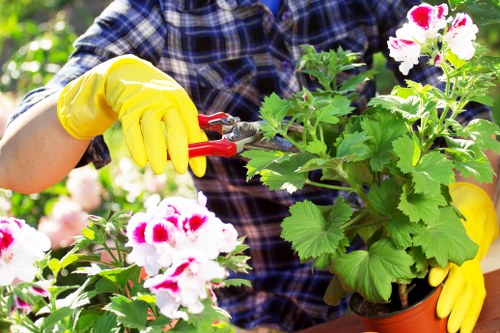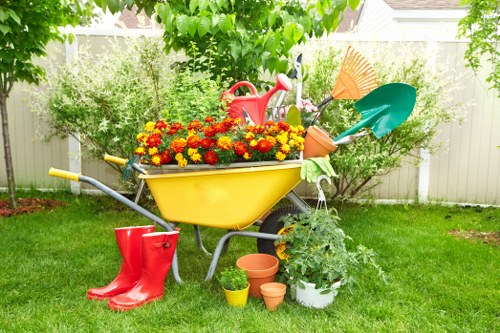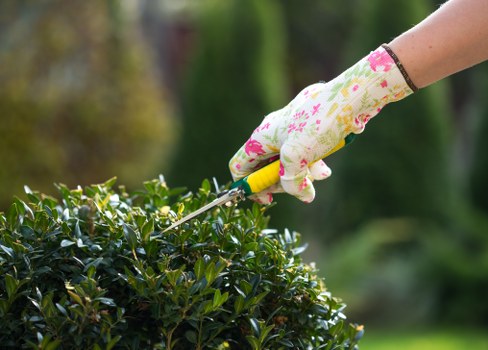Comprehensive Guide to Garden Maintenance with Your Lawn Mower
Understanding the Importance of Regular Lawn Maintenance

Maintaining a beautiful garden is a rewarding endeavor that not only enhances the aesthetic appeal of your home but also provides a serene environment for relaxation and outdoor activities. **Regular garden maintenance** is essential for ensuring the health and longevity of your plants, shrubs, and overall landscape.
One of the fundamental aspects of garden maintenance is the use of a reliable lawn mower. A lawn mower is not just a tool for cutting grass; it plays a pivotal role in shaping the health and appearance of your lawn. By keeping the grass at an optimal height, you promote **stronger root systems**, reduce the growth of weeds, and enhance the overall vigor of your garden.
Consistent mowing also helps in preventing common lawn problems such as diseases and pests. When grass is cut too short, it becomes more susceptible to damage from environmental factors like extreme temperatures and heavy rainfall. Therefore, maintaining the right mowing schedule is crucial for a thriving garden.
Choosing the Right Lawn Mower for Your Garden

Selecting the appropriate lawn mower is a critical decision that can significantly impact your garden maintenance routine. There are various types of lawn mowers available, each designed to meet different needs and preferences.
**Electric lawn mowers** are an excellent choice for small to medium-sized gardens. They are environmentally friendly, produce less noise, and require minimal maintenance compared to their gas-powered counterparts. Additionally, electric mowers are lightweight and easy to maneuver, making them ideal for gardens with intricate layouts and tight spaces.
On the other hand, **gas-powered lawn mowers** are more suitable for larger gardens with extensive grass coverage. They offer more power and can handle tougher grass and uneven terrains with ease. However, they tend to be noisier and require regular engine maintenance, including fuel management and spark plug replacements.
Essential Lawn Mower Maintenance Tips

To ensure your lawn mower performs efficiently and lasts for years, regular maintenance is paramount. Here are some essential tips to keep your mower in top condition:
- Blade Care: Regularly sharpen the mower blades to ensure clean cuts. Dull blades can tear the grass, leading to brown patches and increased vulnerability to pests.
- Oil Changes: For gas-powered mowers, change the oil as recommended by the manufacturer. Clean oil helps in the smooth operation of the engine and prevents wear and tear.
- Air Filter Replacement: A clean air filter ensures proper airflow to the engine, enhancing performance and fuel efficiency. Replace the air filter periodically based on usage.
Additionally, always clean the mower deck after each use to remove grass clippings and debris. This prevents clogging and ensures that the mower operates smoothly during the next use.
Storing your lawn mower properly is also crucial. Keep it in a dry, sheltered area to protect it from the elements. For gas-powered mowers, consider draining the fuel if you won't be using the mower for an extended period.
Advanced Tips for Efficient Garden Maintenance

Taking your garden maintenance to the next level involves incorporating advanced techniques and tools that enhance efficiency and effectiveness. Here are some strategies to consider:
- Mulching: Apply a layer of mulch around plants to retain moisture, suppress weeds, and regulate soil temperature. Mulching also adds a neat and finished look to your garden.
- Smart Irrigation Systems: Implementing a smart irrigation system can optimize water usage, ensuring that your plants receive the right amount of water without waste.
- Integrated Pest Management: Use a combination of biological, cultural, and mechanical methods to control pests in your garden, reducing the need for chemical interventions.
Moreover, consider investing in robotic lawn mowers. These automated devices can maintain your lawn with minimal intervention, freeing up your time for other gardening tasks.
Regularly assessing the health of your plants and soil can help in identifying and addressing issues promptly. Soil testing, for instance, can provide valuable insights into nutrient levels and pH balance, allowing you to make informed decisions about fertilization and soil amendments.
Seasonal Lawn Care Strategies

Different seasons bring unique challenges and opportunities for garden maintenance. Adapting your lawn care routine to the changing seasons can significantly impact the health and appearance of your garden.
**Spring** is the time to prepare your garden for the growing season. Start by cleaning up any debris from the winter months, aerating the soil, and applying a balanced fertilizer. Regular mowing during spring helps in promoting new growth and maintaining an even lawn.
**Summer** demands diligent watering and mowing to cope with the heat and potential drought conditions. Keep your grass at a slightly higher height to provide shade to the roots and retain soil moisture. Implementing a deep watering schedule can encourage deeper root growth, enhancing the resilience of your lawn.
- Fall: As temperatures begin to drop, reduce the frequency of mowing and start preparing your lawn for the winter. Aerate the soil, apply a winterizer fertilizer, and address any last-minute weed control.
- Winter: Protect your lawn from harsh weather conditions by minimizing foot traffic and avoiding heavy equipment use. Clear any fallen leaves and debris to prevent mold and mildew growth.
Common Lawn Care Mistakes to Avoid
Even with the best intentions, gardeners can sometimes make mistakes that hinder the health and beauty of their lawns. Being aware of these common pitfalls can help you maintain a vibrant and healthy garden:
- Mowing Too Short: Cutting the grass too short can stress the plants, making them more susceptible to diseases and pests. Always adhere to the recommended grass height for your specific lawn type.
- Overwatering: Excessive watering can lead to root rot and create an environment conducive to weed growth. Implement a balanced watering schedule based on your lawn's needs and environmental conditions.
- Ignoring Lawn Health Signs: Neglecting early signs of lawn distress, such as discoloration or thinning, can result in more severe problems. Regularly inspect your lawn and address issues promptly.
Additionally, avoid using the same mowing pattern repeatedly. Changing your mowing direction each time can prevent the grass blades from developing a consistent leaning direction, promoting even growth and aesthetic appeal.
Using the wrong type of fertilizer or applying it incorrectly can also harm your lawn. Always use fertilizers appropriate for your grass type and follow the application instructions carefully to avoid nutrient burn and environmental harm.
Benefits of Professional Lawn Maintenance Services
While many homeowners manage their garden maintenance independently, there are significant benefits to hiring professional lawn maintenance services. Professionals bring expertise, experience, and specialized equipment to ensure that your garden receives optimal care.
**Time-Saving**: Professional services handle all aspects of garden maintenance, freeing up your time for other activities. From mowing and trimming to fertilizing and pest control, experts manage it all efficiently.
**Expert Knowledge**: Lawn care professionals have in-depth knowledge of different grass types, soil conditions, and environmental factors. They can tailor their services to meet the specific needs of your garden, ensuring healthier and more resilient plants.
- Customized Maintenance Plans: Professionals develop personalized maintenance plans based on your garden's unique characteristics and your preferences. This ensures that every aspect of your garden is attended to meticulously.
- Access to Advanced Equipment: Professional lawn care services utilize advanced tools and machinery that may not be feasible for homeowners to own. This results in more precise and efficient garden maintenance.
Additionally, hiring professionals can lead to long-term cost savings by preventing costly repairs and replacements that may arise from neglected lawn care. Investing in professional services is an investment in the longevity and beauty of your garden.
**Sustainability**: Many professional lawn care companies prioritize environmentally friendly practices, such as using organic fertilizers and implementing sustainable watering techniques. This not only benefits your garden but also contributes to the broader environmental well-being.
Innovations in Lawn Mowing Technology
The landscape of garden maintenance is continually evolving with advancements in technology. Modern lawn mowers incorporate innovative features that enhance efficiency, convenience, and sustainability.
**Robotic Lawn Mowers**: These autonomous devices have revolutionized lawn care by automating the mowing process. Equipped with smart sensors and programmable schedules, robotic mowers can maintain your lawn with minimal intervention, ensuring consistent and precise cuts.
**Smart Connectivity**: Many contemporary lawn mowers offer smart connectivity options, allowing users to control and monitor their mowers via smartphone apps. Features such as schedule management, real-time status updates, and maintenance reminders are easily accessible through these apps.
- Battery-Powered Efficiency: Battery-powered mowers provide a quiet, emission-free mowing experience. Advances in battery technology have extended their run times and charging capabilities, making them a viable option for larger gardens.
- Adjustable Cutting Heights: Modern mowers offer adjustable cutting heights, enabling gardeners to customize the grass length based on seasonal needs and grass type. This flexibility contributes to healthier and more resilient lawns.
Moreover, some lawn mowers come equipped with mulching capabilities, allowing them to finely chop the grass clippings and redistribute them as natural fertilizer. This reduces the need for chemical fertilizers and promotes sustainable garden practices.
Integrating these technological innovations into your garden maintenance routine can lead to enhanced efficiency, reduced labor, and a more sustainable approach to lawn care.
Eco-Friendly Lawn Maintenance Practices
Adopting eco-friendly lawn maintenance practices is not only beneficial for the environment but also promotes a healthier and more sustainable garden. Here are some strategies to consider:
- Organic Fertilizers: Use organic fertilizers to supply essential nutrients to your lawn without the harmful effects of chemical alternatives. Compost and natural fertilizers improve soil health and promote microbial activity.
- Water Conservation: Implement water-saving techniques such as drip irrigation, rainwater harvesting, and scheduling watering during early morning or late evening hours to reduce evaporation.
- Natural Pest Control: Utilize biological pest control methods, such as introducing beneficial insects, to manage pests naturally without resorting to chemical pesticides.
Additionally, maintaining a higher grass height can contribute to a healthier lawn by providing shade to the roots, reducing water evaporation, and enhancing resistance to pests and diseases.
Using electric or battery-powered lawn mowers further minimizes your carbon footprint by eliminating emissions and reducing noise pollution. Hybrid models that combine manual and powered mowing options offer flexibility and sustainability.
Maximizing the Lifespan of Your Lawn Mower
Ensuring that your lawn mower remains in optimal condition extends its lifespan and maintains its performance. Here are some tips to maximize the longevity of your mower:
- Regular Cleaning: After each use, clean the mower deck and blades to prevent grass buildup and rust formation. Use a brush or a hose to remove debris, ensuring that all components are dry before storage.
- Proper Storage: Store your lawn mower in a dry, sheltered area to protect it from moisture and extreme temperatures. For gas-powered models, drain the fuel or use a fuel stabilizer to prevent engine issues during storage.
- Routine Inspections: Regularly inspect your mower for signs of wear and tear. Check belts, blades, and other moving parts for damage, and replace them as needed to ensure safe and efficient operation.
Additionally, follow the manufacturer's maintenance schedule and guidelines to keep your mower running smoothly. Keeping detailed records of maintenance activities can help in tracking the mower's condition and addressing issues promptly.
Investing in quality parts and accessories, such as spare blades and air filters, can also contribute to the mower's longevity. Quality components are more durable and can withstand regular use, reducing the need for frequent replacements.
Optimizing Mowing Patterns for a Healthier Lawn
The way you mow your lawn affects its health and appearance. Optimizing mowing patterns can promote even growth, reduce soil compaction, and prevent grass from developing a preferred direction.
**Varying Directions**: Change your mowing direction each time you mow. For instance, mow north to south one week and east to west the next. This practice prevents the grass from leaning consistently in one direction and promotes balanced growth.
**Mowing Frequency**: During peak growing seasons, mow your lawn more frequently to maintain the optimal grass height. Typically, mowing once a week is sufficient, but this can vary based on grass type and growth rate.
- Cutting Height: Adjust the mower's cutting height based on the season and grass type. Keeping the grass slightly taller in summer helps retain moisture and provides shade to the roots.
- Sharp Blades: Ensure that your mower blades are sharp to make clean cuts. Dull blades can tear the grass, leading to a ragged appearance and increased susceptibility to diseases.
Additionally, consider leaving grass clippings on the lawn as a natural mulch. Clippings decompose quickly, returning valuable nutrients to the soil and reducing the need for additional fertilization.
Adhering to these mowing practices fosters a healthy, resilient lawn that can withstand environmental stresses and resist weed invasions.
Integrating Lawn Mowing with Overall Garden Maintenance
Lawn mowing is a central component of garden maintenance, but it should be integrated with other practices to achieve a harmonious and well-maintained landscape.
**Pruning and Trimming**: Regular pruning of shrubs and trimming of hedges complements mowing by maintaining the overall shape and structure of your garden. It also encourages healthy growth and prevents overgrowth that can overwhelm other plants.
**Weed Control**: Effective weed control involves a combination of mowing, manual removal, and the use of natural or chemical weed inhibitors. Keeping your lawn mowed at the correct height can suppress weed growth by limiting their access to sunlight.
- Soil Health: Maintaining healthy soil through regular aeration, composting, and the use of organic fertilizers ensures that your lawn and garden plants receive the necessary nutrients for optimal growth.
- Pest Management: Implementing integrated pest management strategies helps in controlling pests without harming beneficial insects or the environment.
By combining these practices with regular lawn mowing, you create a balanced ecosystem that supports healthy plant growth and minimizes maintenance challenges.
**Landscape Design**: Thoughtful landscape design enhances the beauty and functionality of your garden. Incorporate elements such as flower beds, pathways, and water features to create an inviting and visually appealing outdoor space.
Seasonal Mowing Schedules for Optimal Lawn Health
Adjusting your mowing schedule according to the seasons ensures that your lawn receives the care it needs throughout the year. Here's how to adapt your mowing routine for each season:
- Spring: As grass begins to grow rapidly, increase the frequency of mowing. Ensure that you remove any winter debris and aerate the soil to promote healthy root development.
- Summer: Maintain a consistent mowing schedule, but avoid cutting too much grass at once. Leave the grass slightly longer to provide shade and retain moisture during hot weather.
- Fall: Gradually reduce mowing frequency as grass growth slows. Prepare your lawn for winter by removing fallen leaves and applying a final round of fertilizer.
- Winter: Minimize mowing during the dormant season. Clear any snow or ice from the lawn to prevent mold and mildew growth.
Additionally, monitor your lawn's growth rate and adjust the mowing schedule as needed. Factors such as rainfall, temperature, and soil fertility can influence how quickly your grass grows, necessitating more frequent mowing during periods of rapid growth.
**Special Considerations**: Some grass types may require specific mowing heights and schedules. Understanding the particular needs of your grass species ensures that you provide the best care possible for your lawn.
Enhancing Lawn Health Through Proper Mowing Techniques
Proper mowing techniques play a significant role in maintaining a healthy and attractive lawn. Implementing these techniques can prevent common lawn problems and promote robust growth.
**Mowing Frequency and Height**: Avoid cutting more than one-third of the grass height in a single mowing session. Cutting too much at once can stress the grass and hinder its ability to recover. Adjust the mower's cutting height to accommodate seasonal changes and grass growth patterns.
**Clean, Sharp Blades**: Keeping mower blades clean and sharp ensures that they make precise cuts, reducing the risk of disease and promoting quicker healing of grass blades. Dull blades can tear the grass, leading to a rough texture and increased vulnerability to pests.
- Mowing Speed: Maintain a steady and moderate mowing speed to allow the blades to cut the grass efficiently. Moving too quickly can result in uneven cuts, while moving too slowly can cause scalping.
- Grass Clippings: Consider leaving grass clippings on the lawn to serve as a natural mulch. Clippings return essential nutrients to the soil as they decompose, reducing the need for additional fertilizers.
**Edge Trimming**: Use an edger or trimmer to maintain clean borders along sidewalks, driveways, and flower beds. This not only enhances the visual appeal of your lawn but also prevents grass from encroaching into unwanted areas.
**Pattern Variation**: Vary your mowing patterns to prevent the grass from developing preferred growth directions. Alternating between different mowing directions each session encourages an even and upright lawn.
Integrating Sustainable Practices in Lawn Maintenance
Embracing sustainable practices in lawn maintenance contributes to environmental conservation and promotes a healthier ecosystem within your garden.
**Composting**: Collect grass clippings and organic waste to create compost. Compost enriches the soil with essential nutrients, enhancing its fertility and structure.
**Organic Pest Control**: Use natural pest deterrents such as neem oil, garlic sprays, or introducing beneficial insects to manage pest populations without harming the environment.
- Water Management: Implement rain barrels and rain gardens to capture and utilize rainwater effectively. This reduces reliance on tap water and prevents runoff that can carry pollutants into local waterways.
- Native Plants: Incorporate native plant species into your garden design. Native plants are adapted to the local climate and require less water and maintenance, promoting biodiversity and sustainability.
Additionally, reduce the use of chemical fertilizers and pesticides by adopting integrated lawn care practices. These methods prioritize natural solutions and sustainable techniques, fostering a balanced and eco-friendly garden environment.
**Energy-Efficient Equipment**: Invest in energy-efficient lawn mowers, such as electric or battery-powered models, to minimize energy consumption and reduce your carbon footprint.
Final Thoughts on Garden Maintenance with Lawn Mowers
Effective garden maintenance is a blend of proper lawn mowing, strategic planning, and sustainable practices. By choosing the right lawn mower, adhering to regular maintenance schedules, and implementing advanced care techniques, you can cultivate a vibrant and healthy garden that stands the test of time.
Remember that a well-maintained lawn not only enhances the beauty of your home but also contributes to a healthier environment and provides a space for relaxation and enjoyment.
Contact us today to learn more about our expert lawn maintenance services and transform your garden into a lush, green paradise. Book your service now and experience the difference a professionally maintained garden can make.